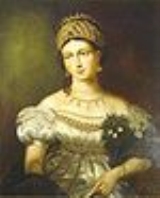
Louise of Saxe-Gotha-Altenburg
Encyclopedia
Princess Louise of Saxe-Gotha-Altenburg (Louise Dorothea Pauline Charlotte Fredericka Auguste; 21 December 1800 – 30 August 1831) was the wife of Ernst I, Duke of Saxe-Coburg and Gotha
and the mother of Duke Ernst II and Prince Albert, husband of Queen Victoria.
(her namesake).
, sixteen-year old Louise married her thirty-three year old kinsman Ernst I, Duke of Saxe-Coburg-Saalfeld after he failed to win the hand of a Russian grand duchess. Louise was considered "young, clever, and beautiful".
They had two children: Ernst
, who inherited his father's lands and titles, and Albert, who was later the husband of Queen Victoria.
The marriage was unhappy because of Ernst's infidelities and the couple separated in 1824. St. Wendel, in the Principality of Lichtenberg
, was assigned as her new residence and Louise was forced to leave her two sons behind. Biographer Lytton Strachey
noted in 1921: "The ducal court was not noted for the strictness of its morals; the Duke was a man of gallantry, and it was rumoured that the Duchess followed her husband's example. There were scandals: one of the Court Chamberlains, a charming and cultivated man of Jewish extraction, was talked of; at last there was a separation, followed by a divorce."
Louise died of cancer on 30 August 1831, when she was only 30 years old. Years after her death, Queen Victoria described Louise in a 1864 memorandum
: "The princess is described as having been very handsome, though very small; fair, with blue eyes; and Prince Albert is said to have been extremely like her".
Ernst I, Duke of Saxe-Coburg and Gotha
Ernest I, Duke of Saxe-Coburg and Gotha, formerly Ernest III, Duke of Saxe-Coburg-Saalfeld was the duke of Saxe-Coburg-Saalfeld and from 1826, the first sovereign duke of Saxe-Coburg and Gotha....
and the mother of Duke Ernst II and Prince Albert, husband of Queen Victoria.
Family
Princess Louise was the only daughter of Augustus, Duke of Saxe-Gotha-Altenburg and his first wife Louise Charlotte of Mecklenburg-Schwerin, daughter of Frederick Francis I, Grand Duke of Mecklenburg-Schwerin and Princess Louise of Saxe-Gotha-AltenburgPrincess Louise of Saxe-Gotha-Altenburg (1756–1808)
Princess Louise of Saxe-Gotha-Altenburg, was a member of the House of Saxe-Gotha-Altenburg and a Princess of Saxe-Gotha-Altenburg and a Duchess in Saxony by birth...
(her namesake).
Marriage and issue
On 31 July 1817 in GothaGotha (town)
Gotha is a town in Thuringia, within the central core of Germany. It is the capital of the district of Gotha.- History :The town has existed at least since the 8th century, when it was mentioned in a document signed by Charlemagne as Villa Gotaha . Its importance derives from having been chosen in...
, sixteen-year old Louise married her thirty-three year old kinsman Ernst I, Duke of Saxe-Coburg-Saalfeld after he failed to win the hand of a Russian grand duchess. Louise was considered "young, clever, and beautiful".
They had two children: Ernst
Ernst II, Duke of Saxe-Coburg and Gotha
Ernest II, Duke of Saxe-Coburg and Gotha was the second sovereign duke of the German duchy of Saxe-Coburg and Gotha, reigning from 1844 to his death...
, who inherited his father's lands and titles, and Albert, who was later the husband of Queen Victoria.
The marriage was unhappy because of Ernst's infidelities and the couple separated in 1824. St. Wendel, in the Principality of Lichtenberg
Principality of Lichtenberg
The Principality of Lichtenberg was a small state of the German Confederation owned by a branch of the Saxe-Coburgs which was sold to Prussia and incorporated into the Rhine Province in 1834...
, was assigned as her new residence and Louise was forced to leave her two sons behind. Biographer Lytton Strachey
Lytton Strachey
Giles Lytton Strachey was a British writer and critic. He is best known for establishing a new form of biography in which psychological insight and sympathy are combined with irreverence and wit...
noted in 1921: "The ducal court was not noted for the strictness of its morals; the Duke was a man of gallantry, and it was rumoured that the Duchess followed her husband's example. There were scandals: one of the Court Chamberlains, a charming and cultivated man of Jewish extraction, was talked of; at last there was a separation, followed by a divorce."
Post-divorce
On 31 March 1826 their marriage was officially dissolved. Seven months later, on 18 October 1826, Louise secretly married in St. Wendel her former lover, the Baron Alexander von Hanstein (later created Count of Pölzig and Beiersdrof). In her previous marriage, she had taken great interest in the social life of the principality and was revered as its Landesmutter (literally, "mother of the region"). Nevertheless, this happy life ended in February 1831, when her secret marriage to von Hanstein was discovered and she lost her children permanently.Louise died of cancer on 30 August 1831, when she was only 30 years old. Years after her death, Queen Victoria described Louise in a 1864 memorandum
Memorandum
A memorandum is from the Latin verbal phrase memorandum est, the gerundive form of the verb memoro, "to mention, call to mind, recount, relate", which means "It must be remembered ..."...
: "The princess is described as having been very handsome, though very small; fair, with blue eyes; and Prince Albert is said to have been extremely like her".

